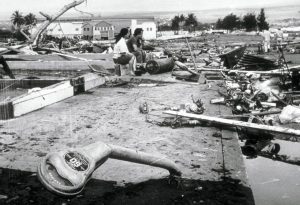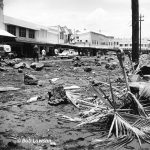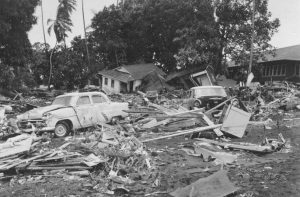 These days, scientist and inventors have collaborated to develop early warning systems for just about any possible disaster, and when everything works as it should, and people heed the warnings, loss of life can often be avoided. Having the technology is great, but technology can’t make human beings do the right things…unfortunately. On May 22, 1960, twelve years after tsunami warnings were developed, and with the warning system in good working order, a massive 9.5 earthquake struck off the coast of Chili. It was the largest earthquake ever recorded. Unfortunately, we don’t really have an earthquake warning, and so without warning, 1655 people lost their lives in Chili and 3,000 injured in the quake. Two million people were made homeless, and damage was estimated at $550 million. The earthquake, involving a severe plate shift, caused a large displacement of water off the coast of southern Chile at 3:11pm. Traveling at speeds in excess of 400 miles per hour, the tsunami moved west and north. On the west coast of the United States, the waves caused an estimated $1 million in damages, but were not deadly. Everyone assumed that the worst was over.
These days, scientist and inventors have collaborated to develop early warning systems for just about any possible disaster, and when everything works as it should, and people heed the warnings, loss of life can often be avoided. Having the technology is great, but technology can’t make human beings do the right things…unfortunately. On May 22, 1960, twelve years after tsunami warnings were developed, and with the warning system in good working order, a massive 9.5 earthquake struck off the coast of Chili. It was the largest earthquake ever recorded. Unfortunately, we don’t really have an earthquake warning, and so without warning, 1655 people lost their lives in Chili and 3,000 injured in the quake. Two million people were made homeless, and damage was estimated at $550 million. The earthquake, involving a severe plate shift, caused a large displacement of water off the coast of southern Chile at 3:11pm. Traveling at speeds in excess of 400 miles per hour, the tsunami moved west and north. On the west coast of the United States, the waves caused an estimated $1 million in damages, but were not deadly. Everyone assumed that the worst was over. 
Nevertheless, warnings were sent to the Hawaiian islands. The Pacific Tsunami Warning System properly and warnings were issued to Hawaiians six hours before the wave’s expected arrival. The response of some people, however, was reckless and irresponsible. Some people ignored the warnings, and others actually headed to the coast in order to view the wave. Arriving 15 hours after the quake, only a minute after predicted, the tsunami destroyed Hilo Bay, on the island of Hawaii. Thirty five foot waves bent parking meters to the ground and wiped away most buildings, destroying or damaging more than 500 homes and businesses. A 10 ton tractor was swept out to sea. Reports indicate that the 20 ton boulders making up the sea wall were moved 500 feet. Sixty-one people died in Hilo, the worst-hit area of the island chain. Damage was estimated at $75 million. This tsunami caused little damage elsewhere in the islands, where wave heights were in the 3-17 foot range. The tsunami continued to race further west across the Pacific. Ten thousand miles away from the earthquake’s epicenter. Japan, received warning, but wasn’t able to warn the people in harm’s way. At about 6pm, more than a day after the quake, the tsunami hit the Japanese islands of Honshu and Hokkaido. The  crushing wave killed 180 people, left 50,000 more homeless and caused $400 million in damages. The Philippines, also hit, saw 32 people dead or missing.
crushing wave killed 180 people, left 50,000 more homeless and caused $400 million in damages. The Philippines, also hit, saw 32 people dead or missing.
Tsunami warnings definitely save lives, but only if people will heed the warnings. As long as people decide that the warning doesn’t apply to them, and give in to their curiosity to go have a look, there will continue to be deaths. It seems a great shame that inventors and scientist work so hard to make a warning to save lives, and then some people refuse to do what is necessary to be safe after they have been warned. I simply don’t understand how people can ignore these warnings and take a chance with their lives.


One Response to Ignored Warning